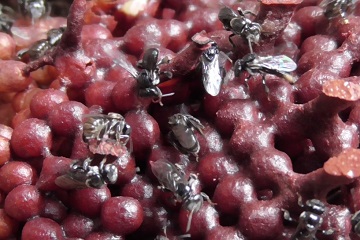Researchers of IPB Revealed the Role of Trigona Laeviceps Bees in the Production of Kailan Seeds

Kailan plant was one of the leavy vegetable plants that had a good prospect for being cultivated. Some important problems in the cultivation of kailan plants were the formation of the relatively low seeds and the pest attacks that might affect the seed production. The kailan flower could do its own pollination, but the success of the plant through the cross-pollination was higher than the plant through its pollination alone.
The kailan flowers with the type of compound flowers and small size were visited by many bees including Trigona laeviceps. Trigona laeviceps (Apidae: Melliponini) was known to be an effective pollinating bee and was able to increase the production of fruits and seeds of various agricultural plants.
Three researchers consisting of Tri Atmowidi and Anggreny Pramitha Wulandari for the Study Program of Animal Biosciences, School of Postgraduate, Bogor Agricultural University (IPB); along with Sih Kahono from the Ecology Laboratory, Zoology Field, Research Center for Biology of LIPI, conducted the research to study the activity of the visit and the role of T. laeviceps bee in the pollination of the kailan plant.
“The bee has an important role in the plant pollination, especially the social bees that collect nectar and pollen. The social bees are known as the potential pollinating agents that can increase the agricultural production. The stingless bees (Apidae: Melliponinae) are the social bees that have no sting. The bee of T. laeviceps is one species of stingless bees that play an important role in the pollination of plants in the tropics,” said Tri.
In the experiment, the researchers used three treatments, namely the caged kailan cultivation and given a colony of T. laeviceps; the open cultivation given one colony of T. laeviceps; and the caged cultivation without T. laeviceps bee (control). The activity of the visit of T. laeviceps was observed during the flowering taking place with the visual observation.
From the experiment, the team found that the length of the visit of T. laeviceps per flower was the highest occurred at 09.00-10.00 (36.3 seconds/flower) with the number of flowers visited of 8.26 flowers per 5 minutes. The length of the visit per flower was the lowest occured at 15.00-16.00 (10.6 seconds per flower) with the number of flowers visited 28.57 flowers per five minutes.
The researchers also observed this bee-borne pollen. The amount of pollen was brought by T. laeviceps in more caged cultivation (8,125 seeds) compared to the open cultivation (3,000 seeds). The viability of the kailan pollen in the cultivation caged with T. laeviceps 80.8 percent (%) was higher compared to the open cultivation (31.4 %). The pollination by T. laeviceps in the caged cultivation increased 141 % of total pods per plant, 48 % of the number of seeds per pod, 204 % of the seed weight per plant, and 177 % of the seed germination compared to the control cultivation.
From these observations, it could be concluded that the activity of the visit of T. laeviceps on closed and open plantation was on high kailan flowers in the morning, and reached its peak at 11.00 and dropped back in the afternoon. In the morning, the average of the visit of T. laeviceps on flowers was 36.3 seconds per flower and visited 8.26 flowers for five minutes. In the afternoon, the activity of the visit on the flowers started to decline, the average of the visit of T. laeviceps on the flowers was 10.6 seconds per flower and visited 28.57 flowers for five minutes.(IR/nm)



